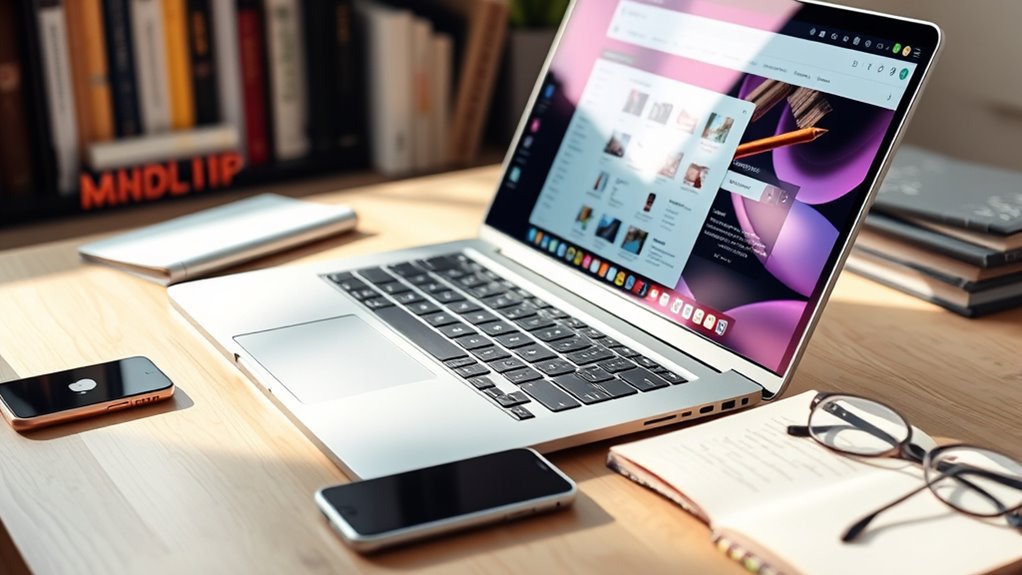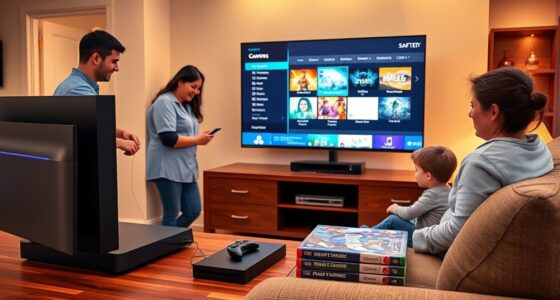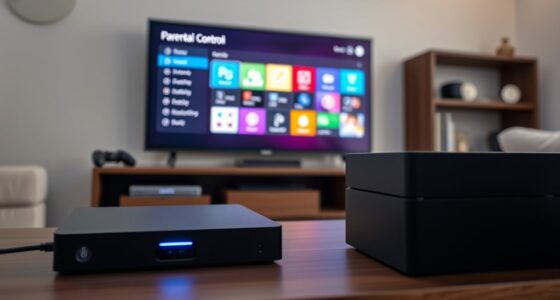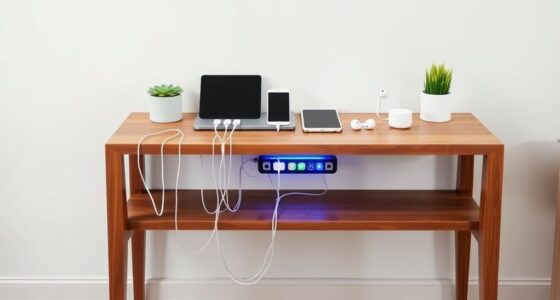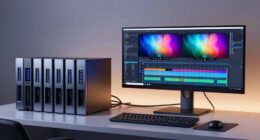To choose the right laptop, first consider what you’ll use it for—basic tasks like browsing or demanding work like gaming or creative projects. Evaluate specs such as processor, RAM, and storage to match your needs, and decide on an operating system that fits your preferences. Think about display size and portability if you’ll be on the go. If you’re curious about more details, you’ll discover how to find the best fit for your specific use.
Key Takeaways
- Identify your primary use, such as basic tasks, gaming, creative work, or professional applications.
- Determine the necessary specifications, including processor type, RAM, storage, and graphics capabilities.
- Consider portability factors like weight, battery life, and screen size based on your mobility needs.
- Choose an operating system that aligns with your software preferences and ecosystem (Windows, macOS, Chrome OS, Linux).
- Set a budget and compare models to find the best balance of features, performance, and value for your needs.

Choosing the right laptop depends on understanding your specific needs and how you’ll use the device. If your tasks are light, like browsing the web, paying bills online, checking email, and social networking, you don’t need a powerhouse. A basic model with modest specs will handle these activities easily and affordably. But if your work involves storing and streaming music or movies, creating documents, or working with spreadsheets, you’ll want a laptop with more robust features. Aim for a machine with at least 8GB of RAM and a decent processor to keep things running smoothly.
Choose a basic laptop with modest specs for light tasks like browsing, email, and social media.
For demanding tasks like multitasking with multiple tabs, using resource-intensive programs, or editing photos and videos, you’ll need a more powerful setup. Look for laptops with multi-core processors such as Intel i7 or AMD Ryzen equivalents, which handle multitasking better. High-resolution screens—preferably Full HD or 4K—are essential for detailed editing work. Consider models with dedicated graphics cards if you plan to do serious gaming or graphics work, as integrated graphics won’t cut it in those cases.
Gaming requires special attention. You should pick a laptop with a dedicated GPU and a high-performance processor to guarantee smoother gameplay. These machines usually have larger screens, often 15 inches or more, and feature advanced cooling systems to prevent overheating during extended gaming sessions. On the other hand, if you’re a creator or professional involved in design, video editing, or 3D modeling, prioritize high-resolution displays, powerful processors, and ample storage. A large SSD with at least 256GB capacity ensures quick access to your files and applications, while more storage space might be necessary for bigger projects.
Operating systems also influence your choice. Windows offers broad software compatibility and hardware options, making it versatile for most users. macOS provides an intuitive interface and strong security features, ideal if you’re already invested in the Apple ecosystem. Chrome OS is perfect for basic tasks like browsing and Android app support, especially for students or casual users. Linux appeals to developers because of its customizability and open-source nature. If you need the flexibility to run multiple OSs, consider dual-booting.
Processor performance is a key factor. Intel’s i3 to i9 range suits different needs—i3 for basic use, i7 or i9 for demanding tasks. AMD Ryzen processors offer similar performance and are often priced competitively. Pay attention to GHz ratings and multi-core capabilities, as higher speeds and more cores improve multitasking and overall responsiveness. Battery life matters too; lower power consumption can extend your usage away from outlets.
Memory and storage choices impact your experience. Aim for at least 8GB of RAM, with 16GB or more for heavy multitasking. SSDs provide faster performance than HDDs, especially with a capacity of 256GB or higher. Hybrid options combine both for speed and storage, while cloud storage can supplement local options. Display size and resolution depend on portability needs and work type. Larger screens with high resolution are better for detailed work but less portable. Touchscreens are useful for 2-in-1 models, and a lightweight, durable build with a comfortable keyboard and long battery life are vital for frequent travelers or busy users.
Additionally, color accuracy in displays can significantly enhance your visual experience, making it especially important for creative professionals.
Frequently Asked Questions
How Do I Determine the Best Battery Life for My Usage?
To determine the best battery life for your usage, first consider how long you’ll be away from power sources. If you do heavy tasks like gaming or video editing, look for laptops offering at least 15-20 hours. For light activities, under 12 hours might suffice. Think about your portability needs, typical workload, and past battery performance to find a device that matches your daily demands.
What Are the Key Differences Between SSD and HDD Storage?
When comparing SSDs and HDDs, you’ll notice SSDs store data on flash memory chips, offering faster access, quicker boot times, and better durability since they have no moving parts. HDDs use spinning disks and mechanical arms, making them slower and more prone to damage but usually cheaper for larger storage. Choose SSDs for speed and portability, while HDDs fit budget-friendly, high-capacity storage needs.
Which Laptop Brands Are Most Reliable for Long-Term Use?
When considering reliable laptop brands for long-term use, you should look at Dell, Lenovo, and Apple. Dell’s Latitude and XPS series are built for durability, while Lenovo’s ThinkPads excel in longevity and battery life. Apple’s MacBooks offer high reliability and excellent software integration. Avoid brands like HP if you’re concerned about consistent performance, as they have more mixed reliability reviews. Choosing one of these trusted brands can guarantee your laptop lasts years.
How Important Is Keyboard and Trackpad Quality?
Is keyboard and trackpad quality really that vital? Absolutely. You rely on them daily for typing, navigation, and multitasking. High-quality keyboards reduce errors and improve comfort, especially during long sessions. Precise trackpads make navigation smooth and responsive, saving you time. Poor input devices cause frustration and slow workflows. Investing in durable, well-designed keyboards and trackpads ensures your productivity stays high and your device remains reliable over time.
Can I Upgrade Components Like RAM and Storage Later?
You can often upgrade components like RAM and storage later, but it depends on your laptop model. Check if the RAM is soldered or if there are accessible slots, and verify compatibility with your motherboard’s specifications. Use manufacturer tools or manuals to identify upgrade options, and confirm the new parts match the required type and speed. Upgrading can boost performance, but some laptops have limitations that might restrict your choices.
Conclusion
So, now you’re ready to pick the perfect laptop—because nothing says “I’ve made it” like a device that meets all your needs… or at least looks impressive while pretending to. Remember, whether you go for the latest gaming beast or a sleek workhorse, just don’t forget to toss in a little patience and a dash of regret for those impulse buys. Happy shopping, and may your new laptop never slow down—unlike your social life.

